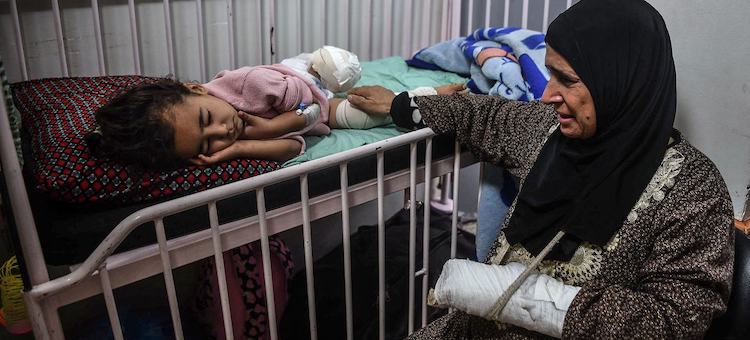By Jaya Ramachandran
GENEVA | 6 January 2024 (IDN) — The UN’s migration agency IOM has launched an urgent appeal for $69 million to support its response to escalating and critical humanitarian needs in the Occupied Palestinian Territories (OPT) and neighbouring countries affected by the ongoing hostilities in Gaza.
In a statement on 5 January, IOM said that hundreds of thousands of civilians need aid desperately. But getting help to them continues to be hampered by “long clearance procedures for humanitarian aid trucks at the border (and) the intense ground operation and fighting”.
“Frequent disruption” to communication networks has also prevented humanitarian aid coordination, the UN agency said, and resulted in “insecurity, blocked roads and scarcity of fuel”.
IOM noted that outside Gaza, the deteriorating security situation along border areas between Israel and Lebanon has forced some 76,000 people from their homes in southern Lebanon.
Since war broke out in the aftermath of the Hamas-led terror attack in southern Israel, hospitals and other vital medical infrastructure in Gaza and the West Bank have been attacked nearly 600 times, according to the UN health agency.
The latest data on healthcare attacks from the World Health Organization (WHO) shows that some 613—606 in Gaza and seven in the West Bank—people have died within health facilities in the Occupied Palestinian Territory (OPT) since 7 October 2923. More than 770 have been injured.
WHO spokesperson Christian Lindmeier condemned the continuing fighting and bombardment and said that the “ongoing reduction of humanitarian space plus the continuing attacks on healthcare are pushing the people of Gaza to breaking point”.
As cases of diseases rise, nutrition plummets and the escalation in hostilities approached the fourteenth week, children in the Gaza Strip faced a deadly triple threat to their lives, added Lindmeier.
“Thousands of children have already died from the violence, while living conditions for children continue to rapidly deteriorate, with increasing cases of diarrhoea and rising food poverty among children, raising the risk of mounting child deaths.”
Hundreds of facilities knocked
WHO’s online platform covering raids on healthcare counted 304 strikes in the Gaza Strip since 7 October. The attacks affected 94 health care facilities (including 26 hospitals damaged out of 36) and 79 ambulances. In the West Bank, 286 attacks caused seven deaths and 52 injuries. Some 24 health facilities were affected, along with 212 ambulances.
The head of the UN Children’s Fund UNICEF stated that children in Gaza “are caught in a nightmare that worsens with every passing day”. “Young lives are “increasingly at risk from preventable diseases and lack of food and water. All children and civilians must be protected from violence and have access to basic services and supplies.”
Catherine Russell noted that cases of diarrhea in children under five increased from 48,000 to 71,000 in just one week starting 17 December, equivalent to 3,200 new cases of diarrhea per day.
She said the significant increase indicated child health in Gaza is “fast deteriorating”. Before the escalation in hostilities, an average of 2,000 cases of diarrhea in children under five were recorded per month.
Relief effort obstructed
A statement released on 4 January by Eri Kaneko, spokesperson for aid coordination office OCHA, echoed repeated concerns by humanitarians that the speed and volume of relief is being continually hampered by conditions on the ground.
“The UN and our humanitarian partners are committed to and continue to do all they can to meet the growing needs in Gaza. However, the operating environment and response capacity continue to be hindered by security risks, mobility constraints, delays, and denials”, Ms. Kaneko said.
“Multiple inspections, long queues of trucks and difficulties at crossing points continue to hamper operations. Inside Gaza, aid operations face constant bombardments, with aid workers themselves killed and some convoys having been shot at.”
The OCHA official made clear other challenges include poor communications, damaged roads and delays at checkpoints. “An effective aid operation in Gaza requires security, staff who can work in safety, logistical capacity and the resumption of commercial activity.”
142 UNRWA staff killed
Meanwhile, the UN agency providing help to Palestinians, UNRWA, said that the total number of staff killed since the beginning of hostilities stands at 142.
The UN Relief and Works Agency for Palestine Refugees also reported that since 7 October last year, up to 1.9 million people have been displaced across the Gaza Strip, some multiple times.
This number represents over 85 per cent of the population of the Gaza Strip, UNRWA said, adding that families have been forced to move “repeatedly in search of safety”.
Nearly 1.4 million internally displaced persons (IDPs) now shelter in 155 UNRWA facilities across all five governorates of the Gaza Strip.
This figure includes 160,000 in the north and Gaza City, according to data last revised shortly after the escalation began.
Another 500,000 people “are in close vicinity of these installations and receiving assistance” from UNRWA, the UN agency said in an update. [IDN-InDepthNews]
Photo: A mother cares for her daughter at Nasser Hospital in Khan Younis in the south of Gaza. © UNICEF/Abed Zaqout












